

David II of Scotland. David II (Medieval Gaelic: Daibhidh a Briuis, Modern Gaelic: Dàibhidh Bruis; Norman French: Dauid de Brus, Early Scots: Dauid Brus; 5 March 1324 – 22 February 1371) was King of Scots from 7 June 1329 until his death.
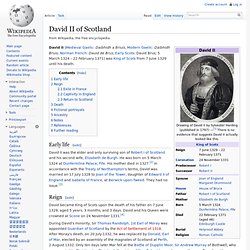
Early life[edit] David II was the elder and only surviving son of Robert I of Scotland and his second wife, Elizabeth de Burgh. He was born on 5 March 1324 at Dunfermline Palace, Fife. His mother died in 1327.[2] In accordance with the Treaty of Northampton's terms, David was married on 17 July 1328 to Joan of the Tower, daughter of Edward II of England and Isabella of France, at Berwick-upon-Tweed. They had no issue.[3] Reign[edit] King David II. David II Feature Page on Undiscovered Scotland.
David II was the son of Robert the Bruce and King of Scotland. David II was born in 1324, the son of Robert the Bruce and his second wife Elizabeth de Burgh.
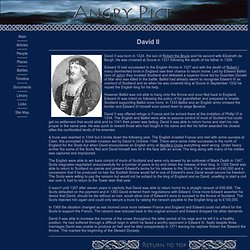
He was crowned at Scone in 1331 following the death of his father in 1329. Edward III had succeeded to the English throne in 1327 and with the death of Robert I many disinherited lords in England saw their chance to return home. Led by Edward Balliol (son of John) they invaded Scotland and defeated a superior force led by Guardian Donald of Mar who was killed in the battle. Balliol had already sworn to recognise Edward III as overlord of Scotland and so when he was crowned king at Scone in September 1332 he repaid the English king for his help. However Balliol was not able to hang onto the throne and soon fled back to England. David II was offered refuge in France and he arrived there at the invitation of Phillip VI in 1334.
A truce was reached in 1344 but it broke down the following year. David II of Scotland. King David II (1324 - 1371, king of Scots from 1329) David was born on March 5th, 1324, in Dunfermline Palace, Fife, Scotland, the only son of King Robert I, Robert the Bruce, hero of Bannockburn, and his second wife, Elizabeth de Burgh.
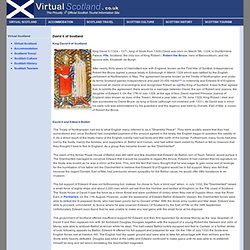
After nearly thirty years of intermittent war with England, known as the First War of Scottish Independence, Robert the Bruce signed a peace treaty in Edinburgh in March 1328 which was ratified by the English parliament at Northampton in May. The agreement became known as the Treaty of Northampton and under its terms Scotland gained independence and paid 20,000 merks*** in indemnity and Edward III of England renounced all claims of sovereignty and recognised Robert as rightful King of Scotland. David II. Medieval and Middle Ages History Timelines - Maps of Medieval History.
RBH Biography: David II, King of Scots (1324-1371) King David II. Robert Bruce's son, David II became king when only 5 years old.

Born of the 5th March 1324 he was instated as the Earl of Carrick. Malcolm Fleming of Garscadden, keeper of Dumbarton Castle, became his 'foster-father' after the death of his mother in 1327. Aged 4 years old, the young Earl was married to Edward III of England's 7 year old sister Joan; a political move that the Scots and English hoped would secure a peace between the two countries. On the death of Robert I, Thomas Randolph the trusted knight became Guardian to the new king. David II was coronated in 1331 but this did not secure his kingship, for Edward Balliol - son of the abdicated King John - had arrived in England looking for support in a bid to reclaim the Balliol lineage to the throne. David Bruce. David Bruce, the only son of Robert the Bruce and his second wife Elizabeth de Burgh was born on 5th March, 1324 at Dunfermline, Fife.
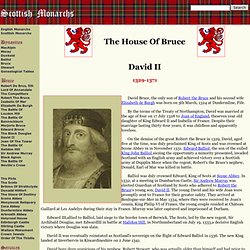
By the terms of the Treaty of Northampton, David was married at the age of four on 17 July 1328 to Joan of England, theseven year old daughter of King Edward II and Isabella of France. Despite their marriage lasting thirty-four years, it was childless and apparently loveless. Scottish History, The House of Bruce David 2nd from Laird Mac Sothis Kings and Queens of Scotland. Scottish History - The House of Bruce David 2nd (A remote highland lochside estate) Have the right to address yourself as The Laird of Glencairn & John O' Groats. ( In Scots law "Laird" is a unisex title but you can buy the title Lady Of as well) Help conserve this unspoiled landscape for you and your descendants £38 (shipping included) David almost lost all that his famous father, Robert the Bruce, had gained.
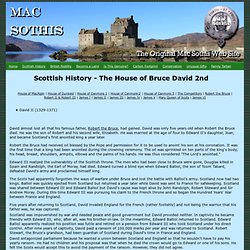
Robert the Bruce had received oil blessed by the Pope and permission for it to be used to anoint his son at his coronation. Overview of King David II. David II of Scotland. The son of Robert the Bruce, David was an infant when his father died in 1329, and a regency was created to rule the country while he was underage.
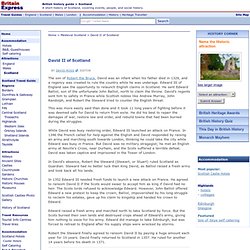
Edward III of England saw the opportunity to relaunch English claims in Scotland. He sent Edward Balliol, son of the unfortunate John Balliol, north to claim the throne. David's regents sent him to safety in France while Scottish nobles like Andrew Murray, John Randolph, and Robert the Steward tried to counter the English threat. This was more easily said than done and it took 11 long years of fighting before it was deemed safe for David to return from exile. He did his best to repair the damages of war, restore law and order, and rebuild towns that had been burned during the struggles. While David was busy restoring order, Edward III launched an attack on France. In David's absence, Robert the Steward (Stewart, or Stuart) ruled Scotland as Guardian.
In 1352 Edward III needed fresh funds to launch a new attack on France. King David II of Scotland. Books & Posters House of Bruce Family Tree Detailed Tree English King or Queen at the Time Name: King David II of ScotlandFather: Robert I, The BruceMother: Elizabeth de BurghRelation to Elizabeth II: 18th great-granduncleHouse of: BruceBorn: March 5, 1324 at Dunfermline, FifeAscended to the throne: June 7, 1329 aged 5 yearsCrowned: November 24, 1331 at Scone Abbey, PerthshireMarried:(1) Joan of England, July 17, 1328Married:(2) Margaret Drummond, February 20, 1364Children: noneDied: February 22, 1371, at Edinburgh Castle, aged 46 years, 11 months, and 18 daysBuried at: Holyrood AbbeySucceeded by: his nephew Robert II David was married at the age of 4 to Joan the 7 year old daughter of Edward II.
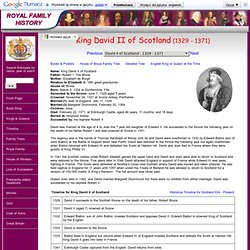
He succeeded to the throne the following year on the death of his father Robert I and was crowned at Scone in 1331. In 1341 the Scottish nobles under Robert Stewart gained the upper hand and David and Joan were able to return to Scotland and were restored to the throne. The Bruces > David II. David II (r. 1329-1371) David II was the elder and only surviving son of Robert I and his second wife, Elizabeth de Burgh.
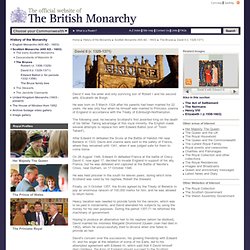
He was born on 5 March 1324 after his parents had been married for 22 years. He was only four when he himself was married to Princess Joanna of England in accordance with the Treaty of Edinburgh-Northampton. The following year, he became Scotland's first anointed king on the death of his father. Taking advantage of this royal minority, the English made several attempts to replace him with Edward Balliol (son of 'Toom Tabard').
After Edward III defeated the Scots at the Battle of Halidon Hill near Berwick in 1333, David and Joanna were sent to the safety of France, where they remained until 1341, when it was judged safe for them to come home. King David II died at Edinburgh Castle - On this day in history. The Maltings, , Bourne, Lincs. PE10 9PH Tel:+44 (0)1778 391000 • Fax: +44 (0)1778 421706 Last Updated: 10th May 2012 This page (together with the documents referred to on it) tells you the terms on which you may use and access our website whether as a guest or a registered user. Please read these terms of use and acceptable use policy (Terms) carefully before you start to use the Site. Second War of Scottish Independence. The Second War of Scottish Independence (1332–1357) was the second cluster of a series of military campaigns fought between the independent Kingdom of Scotland and the Kingdom of England in the late 13th and early 14th centuries.

The Second War arose from lingering issues from the First. The Treaty of Edinburgh-Northampton by which the First War had been settled had never been popularly accepted among the English, and it had created a new group of disenfranchised nobles called the "disinherited" who felt unduly deprived by it of their rights to Scottish lands. Battle of Dupplin Moor. The Battle of Dupplin Moor was fought between supporters of the infant David II, the son of Robert the Bruce, and rebels supporting the Balliol claim in 1332. It was a significant battle of the Second War of Scottish Independence.
The battlefield is currently under research to be inventoried and protected by Historic Scotland under the Historic Environment (Amendment) Act 2011.[1] Background[edit] The death of Robert I in 1329 left Scotland with a four-year-old king, David II (1329–1371). Battle of Neville's Cross. The Battle of Neville's Cross took place to the west of Durham, England, on 17 October 1346. The culmination of a Scottish invasion of northern England, the battle ended with the rout of the Scots and the capture of their king, David II of Scotland. Background[edit] In 1346, England was embroiled in the Hundred Years' War with France.
In order to divert his enemy, Philip VI of France appealed to David II of Scotland to attack the English from the north in order to create a second front for the English. Despite Philip VI's especially desperate pleas in June 1346 (when the English were amassing troops in southern England), David II of Scotland waited until October, when he felt few English troops would be left to defend lucrative Northern English cities. On 7 October, the Scots invaded England with approximately 12,000 men. The battle[edit] Battle of Culblean. Coordinates: The Battle of Culblean was fought on 30 November 1335, during the Second War of Scottish Independence. It was a victory for the Scots led by the Guardian, Sir Andrew Murray over an Anglo-Scots force commanded by David III Strathbogie, titular Earl of Atholl, and a leading supporter of Edward Balliol. Background[edit] King David Bruce coat of arms - Rylands Collection. Www.familyofbruce.org - Family of Bruce International, Inc. - Bruce Biographies.
File:David Bruce, king of Scotland, acknowledges Edward III as his feudal lord.jpg. RoberttheBruceandUsurpingtheLineage. Negotiations for the Ransom of David Bruce in 1349. Margaret Drummond, Queen of Scotland. Margaret Drummond (circa 1340 – after January 31, 1375), known also by her first married name as Margaret Logie, was the second queen of David II of Scotland and a daughter of Sir Malcolm Drummond, Knt.
(died circa 1346) by his wife Margaret Graham, Countess of Menteith. Margaret first married Sir John Logie of that Ilk, having by him a son, John of Logie.[1][2] She later served as a mistress to King David who was widowed from his first wife, Joan of The Tower, on 14 August 1362. Margaret then married David II of Scotland at Inchmurdach in Fife, on 20 February 1364. They had no children and the King divorced her on 20 March 1369 on grounds of infertility. Margaret, however, travelled to Avignon, in southern France, and made a successful appeal to the Pope to reverse the sentence of divorce which had been pronounced against her in Scotland.
Women Warriors in the 14th Century : provided by Lothene Experimental Archaeology.